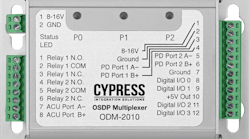A key area where organizations need help from security integrators is in the assessment of their current access control solutions and whether and when to make the transition to new technology. Organizations often delay transitions over budget concerns or because of worries that the process will adversely impact productivity and workflow. But these delays can be dangerous, and integrators offer important perspective and guidance about escalating security threats that place increasing pressure an obsolete access control infrastructure. Based on their extensive experience serving customers across a variety of applications and circumstances, they know it is far more effective to be proactive rather than reactive when making decisions about upgrading to new and improved technology.
There are also many positive reasons that integrators can share with their customers about why they should embrace change. These include enhancing investment value, improving user convenience, and paving a more flexible path to future capabilities. The ability for organizations to embrace these more positive aspects of change requires an access control platform that can meet today’s requirements with the highest levels of security, convenience, and interoperability while enabling organizations to adopt future capabilities without disrupting the ongoing business operations.
These are the advantages of the latest technologies. Integrators can educate their customers about how these technologies enable organizations to presume and prepare for ongoing change, not only to combat continuously evolving security threats but also to anticipate and address new and emerging operational requirements. Today’s systems also enable decision-makers to preserve investments in their current infrastructure as they transition to new technologies and capabilities. The following are 10 common triggers that integrators can share with their customers as they plan for the transition to new and improve access control capabilities:
- There is growing demand for combining many different access control applications on a single card – and adding new ones in the future: Today’s contactless smart cards can be used for many different purposes beyond opening doors, from time and attendance to secure print management and cashless vending. Administration of these functions is centralized into one efficient and cost-effective system. Organizations also can seamlessly add logical access control for network log-on to create a fully interoperable, multi-layered security solution across company networks, systems and facilities.
- Employees increasingly want a mobile option: Today’s access control systems also enable organizations to upgrade their systems to the convenience, flexibility, and security of carrying mobile IDs on smartphones and other devices. Mobility transforms the user experience for a more convenient, trusted and secure digital world, dramatically elevating how users regard security by enabling them to confidently connect to and use more applications, on the go, than ever before, with a single, trusted ID that can be carried on a smart device.
- There is a change to security requirements: An organization may be required to increase its security because there has been new legislation or regulatory requirements. Or, the organization may win a new client or acquire building tenants that necessitate an increase in security. Any of these triggers presents an opportunity to upgrade security at other locations, as well, as part of a larger upgrade to new standardized, centralized systems.
- Company undergoes a merger or acquisition: At some point after an M&A event, an organization will need to issue new credentials. This presents the opportunity to merge what previously were disparate administrative and other systems, technologies, and processes. The investment in new technology is often comparable to the cost of integrating separate legacy systems, so this is the perfect time to migrate to a new, more secure, sophisticated and capable system.
- The headaches of managing multiple cards and systems exceed threshold of frustration: In the same way that an M&A event can trigger the need for access control system consolidation, so can a long period of rapid growth or the use of decentralized administration systems across multiple physical locations. Standardizing and centralizing management of secure identity ensures consistency, higher security and a more efficient use of resources.
- There is a facility consolidation, additions or relocation: Any move or addition will generally trigger the need to issue credentials for the new location. Mass rebadging is much simpler to coordinate and manage using a single, centralized system, making it an ideal time to simultaneously re-examine access control across the entire organization.
- Company rebrands and triggers a re-issuance process: Any time there is a re-branding, companies generally purchase new ID cards for current employees and enough cards to onboard new employees down the road. Forward-thinking decision-makers use this as an opportunity to simultaneously invest in new access control technology with the flexibility and advanced capabilities to carry them well into the future.
- Risk management needs improvement: Organizations often face new, more stringent insurance requirements, or need to reduce their liabilities and associated risk management costs. This can be done by dramatically improving security through a move from an outdated system to one that supports current standards.
- There is the need to adopt strong authentication throughout the organization: Organizations may need to implement the highest levels of security including strong authentication at the door. This requires transitioning to an access control system that supports PIV, PIV-I and CIV cards, along with an easy path to compliance with government requirements, where needed.
- There is a breach or other major security event: Ideally, organizations should upgrade before there is a problem, especially when the current system uses legacy technology that is easily breached. But the reality is that sometimes it takes an unexpected event or security breach to move an organization to make the investment in a new access control system.
When making the jump to a new access control system, it’s also important for organizations to evaluate the companion secure issuance system that will be used to produce the ID cards. Large organizations issue a staggering amount of ID cards every year. Sometimes this issuance is done by a service bureau but, more often; this process is done on site by the organization itself, relying on a desktop printer that personalizes blank or pre-printed card stock with visual cardholder information.
Organizations generally choose from two major technology categories for printing and encoding cards: high definition printing (HDP®) retransfer technology, and direct-to-card (DTC) technology. Ideally, a solution should also support both centralized and distributed issuance models, by combining the high-volume reliability and advanced credentialing features of larger centralized printers with the lower cost and smaller footprint of a distributed printing model.
There are other important secure issuance considerations for integrators to share with their customers, particularly in the areas of energy consumption, overall waste, and cost efficiency. The latest secure issuance systems are significantly more sustainable than in the past. Two key developments include “wasteless” lamination, and reducing carbon footprints as defined through the GreenCircle® certification program.
With wasteless lamination, the lamination patches that are applied to cards for increased durability are attached to one another in a continuous stream of material on a single roll. This eliminates the need for an underlying carrier. As each patch is detached from its supply roll and adhered to a card, the lamination cycle is complete. Once the supply roll has been depleted, all that's left is a single empty core. This process significantly reduces both the cost of the consumables and the waste product. Wasteless lamination has proven to be very cost-effective, reducing lamination consumables costs as much as 50 percent while maintaining the highest levels of security and durability.
GreenCircle certification recognizes the energy savings that are achievable through advancements in card lamination technologies that have reduced the significant energy required to heat up and maintain optimal operating temperature. These technologies can conserve significant amounts of energy while also saving time.
Integrators can help their customers derive significant value from shifting their traditional way of thinking about change, and by looking at it as an opportunity to invest in ongoing operational excellence rather than as the cost associated with reacting to adverse conditions. By showing customers how to take advantage of these 10 common triggers for transition and implement a more sustainable approach to secure issuance, they will deliver two important benefits. First, their customers will be able to easily and inexpensively expand and upgrade their systems to meet changing needs, take advantage of new technologies and capabilities, and produce ID cards in a more environmentally responsible manner. Second, as they evolve beyond current abilities, they will be well-positioned to adapt to and combat continuously changing threats, with the confidence that they can preserve investments in their existing infrastructure.
About the Author: Brandon Arcement is the Director of Product Marketing with HID Global.



